Content
In the first half of the last century, breeders set out to create a new variety of chubushnik, or garden jasmine, as the bush is also called among the people, with an unusual color. Jasmine Belle Etoile was the first successful work of the French originator Lemoine, who bred this variety at the beginning of the 20th century.
Description of the chubushnik Bel Etoile
The compact Bel Etoile jasmine bush in favorable conditions reaches a height of more than one and a half meters. In cold climates, the shrub grows no more than a meter. Its crown volume is not too large and does not exceed one and a half meters.
Oblong dark green and slightly pointed leaves (4 - 5 cm long) acquire a lemon hue over time.
How the garden jasmine Belle Etoile blooms
Large white flowers, collected in small inflorescences up to 5 pieces, have a bright pinkish-purple spot on the corolla. This is the main distinguishing feature of the hybrid. The Belle Etoile mock-orange blooms in late spring. Flowering can last until mid-June. The splendor, longitude of flowering and the size of the corollas largely depend on the growing conditions and the correct care. Unlike most varieties of chubushnik, Bel Etoile garden jasmine is sensitive to conditions. With a lack of nutrients in the soil, a lack of moisture and light, the flowers of this beautiful shrub become smaller, and their flowering period is shorter.
Photo of jasmine bloom Belle Etoile:
The amazing strawberry aroma with notes of exotic fruits has not left indifferent gardeners for many decades.
Choosing a shrub sapling for planting is easy to make a mistake. The varietal characteristics of the shrub become visible when the first flowers appear. In addition to the Belle Etoile mock-orange, there are several more varieties with two-color flowering. But the spots on the corollas of other garden jasmines are less bright.
It is better to purchase seedlings in specialized stores or nurseries, where they can submit documents with a photo and description of the Bel Etoile chubushnik.
Main characteristics
Despite the thermophilicity of the shrub, the Bel Etoile hybrid mock-orange can withstand frosts up to 25 degrees. At lower temperatures, young shoots of the plant suffer. After trimming, the chubushnik grows back easily.
The Bel Etoile variety is relatively resistant to diseases. With an excess of moisture or an incorrectly chosen place for planting, the bush may suffer from leaf spot and some fungal diseases of the trunk and roots.
Garden jasmine Belle Etoile can be attacked by leaf-eating insects. Aphids, spider mites and some other pests are dangerous for the decorative effect of the shrub.
You can watch an overview of the characteristics of the Bel Etoile chubushnik in the video:
Breeding features
Chubushnik Bel Etoile, like other garden jasmines, easily propagates by dividing the bush, layering, cuttings and sowing seeds. But not all methods are equally good for hybrid garden jasmine.
The division of the root of the chubushnik Bel Etoile complicates the size of the bush. It is difficult to dig a highly branched meter plant from the ground without damaging the roots. Therefore, this breeding method is used very rarely.
The easiest way to propagate garden jasmine is by layering or cuttings. These methods allow you to quickly breed a mock-orange in the garden while maintaining the varietal characteristics of the hybrid variety.
Layers can be used to propagate the Belle Etoile chubushnik throughout the season. Young shoots located close to the ground are tilted and secured with hairpins. The foliage must be removed from most of the scion. Otherwise, when backfilling with soil, the future seedling may rot. Care for layering of garden jasmine consists in regular watering. You can plant a bush either in the year of digging, lmbo the next, with a developed root system of the culture.
Experts recommend breeding a varietal mock-orange Bel Etoile by cuttings. The mass of planting material can be obtained by formative pruning of the shrub. Cuttings are harvested in spring and autumn. Autumn billets are stored in a cool basement or buried on the site in places where there is a high snow cover in winter.
To root cuttings of garden jasmine, light sandy loam soil is required. It is required to maintain constant humidity. For this, containers with cuttings are covered with foil or plastic caps.
Cuttings are cut with a sharp knife at an angle of 45 degrees. The length of the workpiece can be from 15 to 25 cm with two pairs of leaves. The upper leaves are cut in half, and the lower ones are removed completely.
For rooting in indoor or greenhouse conditions, cuttings are ready for planting in one and a half to two months.
Planting and caring for Belle Etoile jasmine
To plant a garden mock Bel Etoile, you must choose the right place. The shrub cannot grow well on swampy soils or soils with a close occurrence of groundwater. Garden jasmine needs good drainage so that the moisture-loving plant does not suffer from fungal diseases during the rainy season.
Recommended timing
It is possible to plant the chubushnik Bel Etoile in early spring or early autumn. Spring seedlings require more care, while autumn ones require a mandatory shelter. Young seedlings may suffer frost damage. After all, the winter hardiness of the chubushnik Bel Etoile is not too high.
Site selection and soil preparation
In order for the garden jasmine to actively develop and bloom, the site must be sunny and protected from strong winds. The shrub can grow in partial shade. But at the same time, the decorativeness of the flowering of the chubushnik decreases.
When preparing the soil, it should be borne in mind that this is a long-lived shrub. If you carry out anti-aging pruning in a timely manner, then you can grow a mock-orange in one place for more than 20 years. Therefore, the soil must be highly fertile. Otherwise, garden jasmine will lose its decorative effect over time.
For planting a mock-orange Belle Etual, a mixture of turfy soil, peat, humus and sand is prepared. The pH level should not exceed 7.7.
The interval between separately planted bushes is made from one meter to one and a half. But when creating a hedge from a chubushnik Bel Etoile (Beautiful Star), the shrub is planted at a distance of 50 - 60 cm.
Landing algorithm
For a single planting of a chubushnik, a pit is prepared with a size of 0.5 m in width and length. The depth must be calculated taking into account the location of the root collar of the seedling. Usually they dig a hole about 50 - 60 cm. Sequence of actions:
- Pour 15 - 20 cm of coarse-grained drainage mixture (fragments of bricks and tiles, large pebbles, coal).
- Pour at least a bucket of water into the pit.
- Try on a seedling (its root collar should be no more than 3 cm below the soil level).
- Pour soil with a slide in the middle of the planting pit.
- Install a seedling.
- Spill with water to straighten the roots.
- Cover with soil evenly, lightly tamping it in a circle.
- Mulch the trunk circle with compost or humus.
A few days after planting the chubushnik, you need to monitor the state of the trunk circle. The soil can gradually settle, exposing the root collar. Add soil as needed.
Growing rules
According to the description, Belle Etoile jasmine is quite picky about care. For the normal development of the shrub and its lush flowering, regular watering, weed removal and loosening are needed.
Watering schedule
The first time after planting the chubushnik in the ground, it is required to water it daily. Pour up to 30 liters of water on one bush. In the future, such frequent watering is carried out only in hot and dry weather. In the rainy period, it is enough to water the shrub no more than 1 time per week.
Weeding, loosening, mulching
Weed control around garden jasmine is ongoing. Wild plants not only take away nutrients from the Belle Etoile chubushnik, but can also become a source of infection.
After the first watering, the soil in the near-trunk circle must be loosened to a depth of 8 cm. Next, the soil must be mulched. These actions will help keep it moisture and permeable. If the layer of mulch is made thick enough, then re-loosening will not be required soon.
Feeding schedule
In the spring, before flowering, top dressing is carried out every year. Chubushnik needs organic matter. Growers use cow dung at a dilution of 1 in 10. This amount is enough to fertilize an adult plant or two young shrubs.
Jasmine of the second year of life during the flowering period is fed with mineral fertilizer. You can use ready-made complexes for shrubs or independently make a solution of urea and potassium sulfide, 15 g per 10 liters of water with the addition of 25 g of superphosphate. This amount of solution is enough to feed a bush that has reached its maximum size.
When the mock-orange has faded, gardeners feed it a second time. To restore strength, the shrub needs potash fertilizers. You can use wood ash, dry or dissolved, or potassium sulfate (20 g per bucket of water).
Pruning
Sanitary pruning is done in early spring. After the snow melts, you need to remove frozen shoots and damaged branches. Infected or weak shoots are removed completely "in a stump".
Formative pruning is carried out at the same time, shortening strong shoots by a few centimeters. This stimulates the growth of the bush.
Anti-aging pruning should be carried out no more than 1 time in 7 - 8 years. At the same time, all the old growth is cut out, leaving 4 - 5 strong shoots.
Preparing for winter
Unlike Chubushniks of Vekhov selection (Academician N.K. Vekhov), a guest from France needs shelter for the winter. It is especially important to insulate the plant in winters with little snow.
Before the first snow, you need to cover the root space with a thick layer of mulch. To do this, use a mixture of humus, compost and dry foliage.
Young bushes must be covered with lutrasil or other non-woven material. This is easy to do. In the middle of the bush, a high pole is installed, on which the winter shelter is attached.
Pests and diseases
Garden jasmine Belle Etual is considered resistant to plant diseases, problems arise mainly due to mistakes in care. With severe waterlogging or insufficient soil permeability, the shrub can be affected by gray rot or similar diseases. Treatment consists in removing the affected parts of the bush and treating it with a fungicide.
Bean aphids and weevil beetles are more likely to infect the mock-orange. To combat them, sticky traps are installed and the plants are treated with an insecticide. To avoid contamination of garden jasmine, preventive treatments are carried out in early spring.
Conclusion
Jasmine Belle Etoile is one of the most beautiful of its kind. Thanks to its delicate aroma and original colors, the shrub has been deservedly loved by gardeners for many decades.
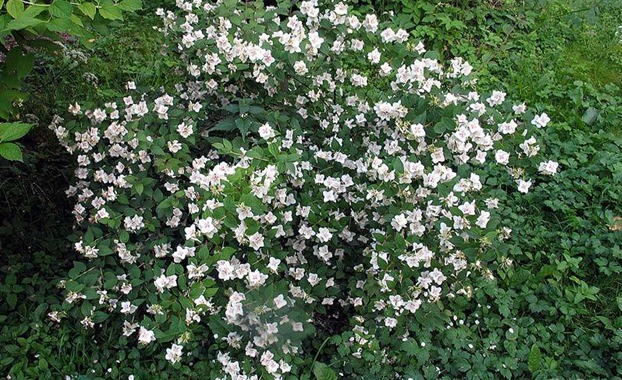
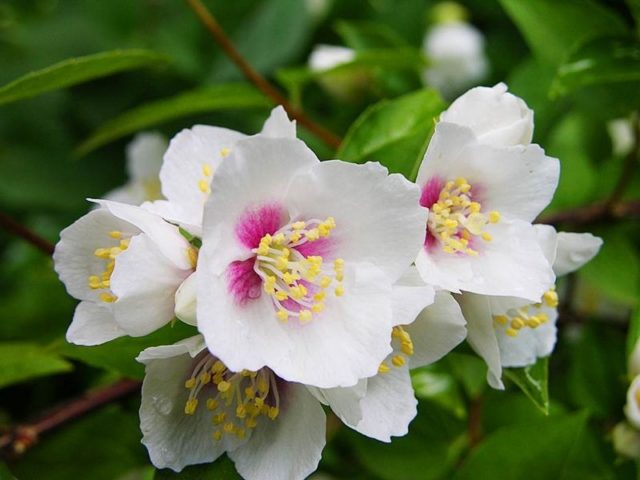

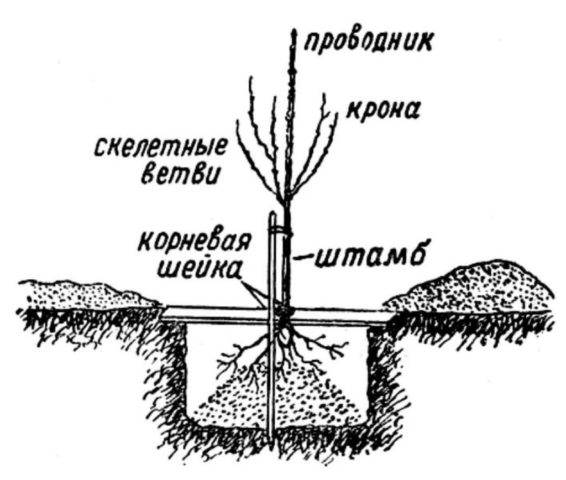
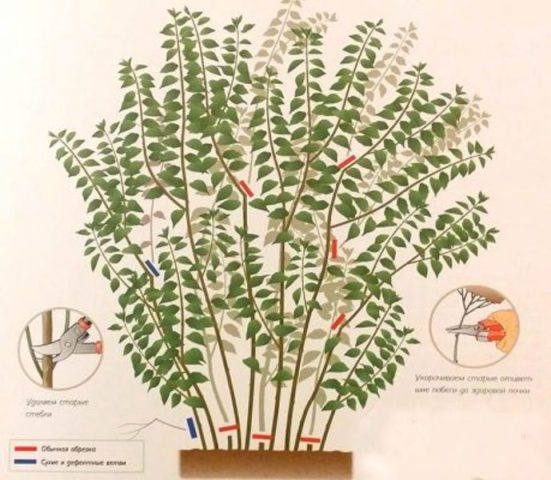
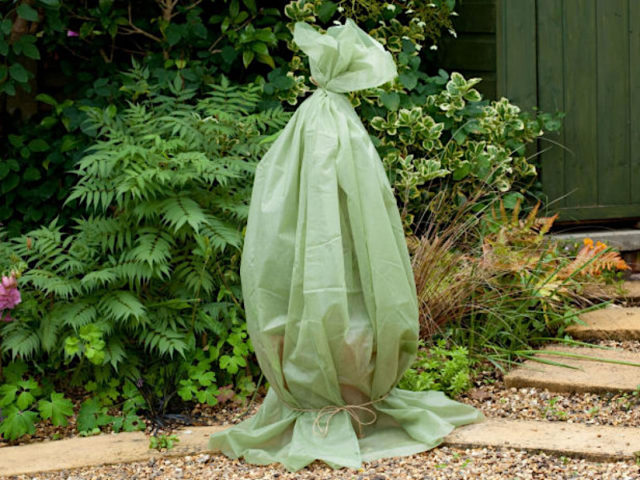

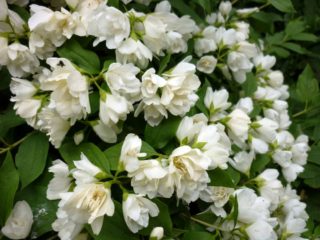

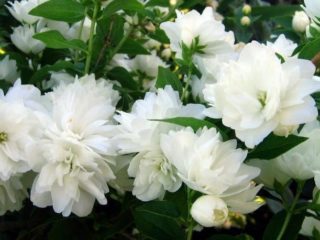
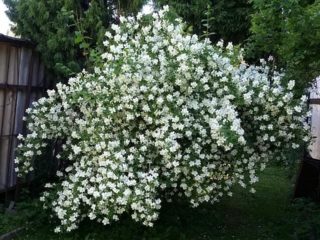



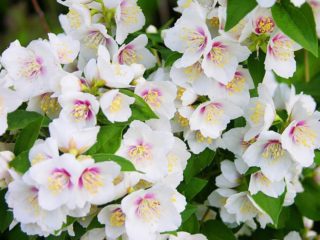

frost resistance of jasmine belle etual?